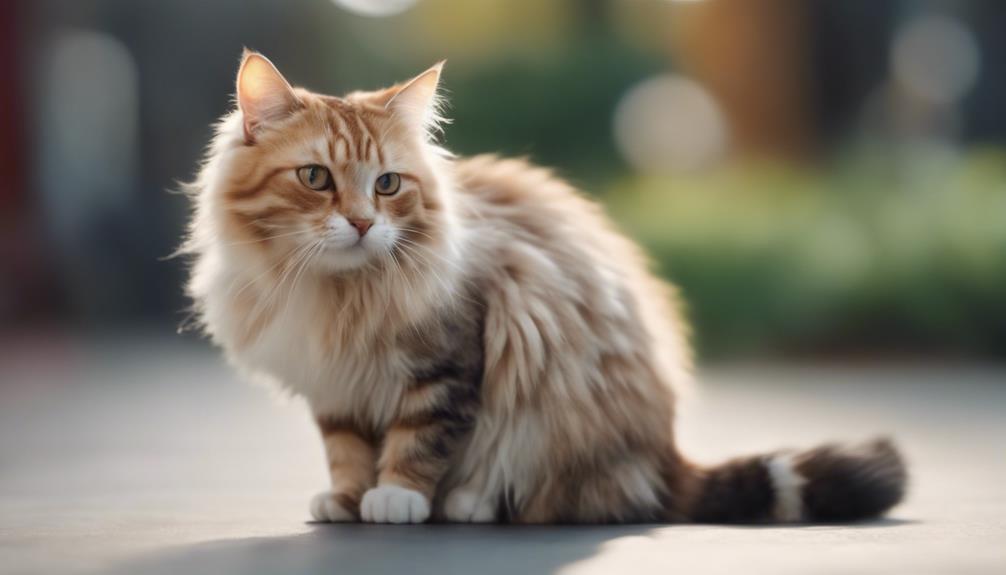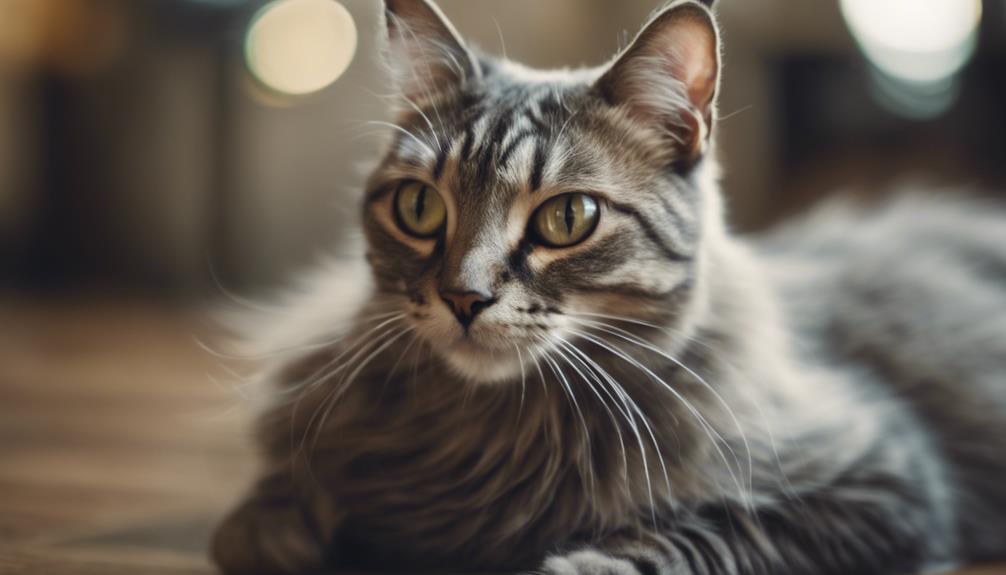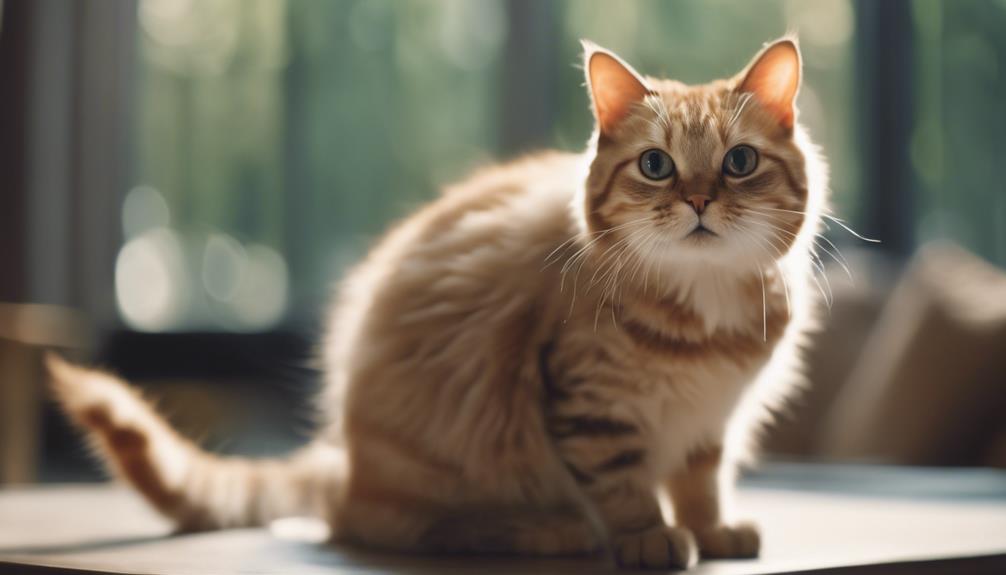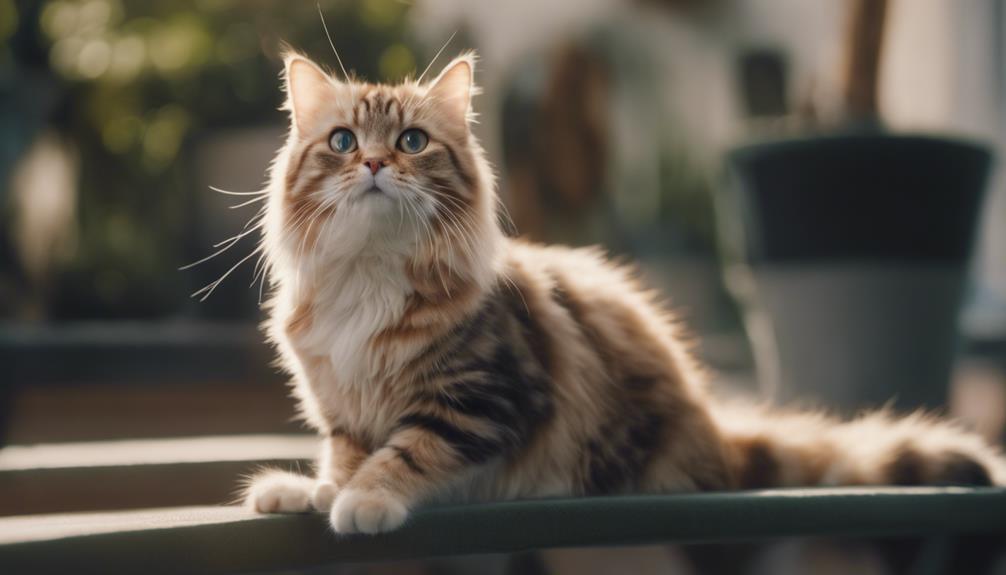Tail wagging in cats is a subtle yet significant form of communication that often eludes many pet owners. While commonly associated with dogs, cats also employ their tails to convey various messages.
Understanding why cats wag their tails can provide crucial insights into their emotions and needs. By unraveling the mysteries behind this behavior, pet owners can establish a deeper connection with their feline companions and foster a more enriching relationship.
Stay tuned as we uncover the hidden meanings behind your cat's tail movements, shedding light on what your feline friend is truly trying to communicate.
Key Takeaways
- Tail wagging in cats can signal aggression, pain, or excitement.
- Understanding cat tail movements helps decipher feline emotions.
- Cats wag their tails to communicate various feelings and needs.
- Decoding tail language enhances cat-human communication.
The Importance of Tail Movements
Tail movements in cats play a crucial role in non-verbal communication, conveying a range of emotions and intentions through subtle gestures. Unlike dogs, which rely heavily on vocalizations, cats have evolved as solitary hunters, necessitating silent forms of communication.
A cat's tail is a barometer of its mood and can provide valuable insights into its state of mind. Understanding the various tail positions and movements can help decipher a cat's feelings, whether it be confidence, aggression, excitement, or readiness to pounce.
Deciphering Tail Signals in Cats
Cats utilize subtle tail movements as a form of non-verbal communication to convey a spectrum of emotions and intentions to their human companions. Understanding these tail signals is crucial in deciphering your cat's feelings.
A cat with its tail held upright typically signifies confidence and trust, while a wagging tail can indicate aggression or pain. Tail shivering or shuddering may reflect excitement or stress, and a tail held straight out and rigid suggests readiness to pounce.
Additionally, a flicking or swishing tail could signal excitement, contemplation, or irritation. By observing and interpreting these tail movements, cat owners can better comprehend their feline's state of mind and respond accordingly to nurture a strong bond.
Unveiling Your Cat's Tail Language

Understanding the subtle nuances of feline body language can offer valuable insights into your pet's emotions and intentions. Cats utilize their tails as a crucial means of communication, expressing a wide array of feelings through various movements.
Each tail position or gesture conveys a specific message, allowing cat owners to better understand and connect with their feline companions. From a straight up tail indicating confidence and trust to a wagging tail signaling aggression or pain, decoding your cat's tail language can enhance your bond and improve communication.
Interpreting Cat Tail Behaviors
When observing feline behavior, paying attention to the subtle movements of their tail can provide valuable insights into their current emotional state and intentions. Understanding cat tail behaviors can help you better communicate with your furry friend.
Here are some key tail movements to interpret:
- Tail Held High: Indicates confidence and contentment.
- Tail Twitching: Reflects excitement or anticipation.
- Puffed-Up Tail: Signifies fear or feeling threatened.
- Tail Curled Around You: Shows affection and a desire for closeness.
Insight Into Feline Tail Communication

Observing the subtle nuances of a cat's tail movements provides valuable insights into their emotional cues and communication signals. Cats use their tails to express a wide range of emotions, from confidence to aggression. Understanding these tail movements can help cat owners better interpret their feline companions' feelings and needs. To engage the audience further, here is a table highlighting some common cat tail movements and their corresponding meanings:
| Tail Movement | Meaning |
|---|---|
| Straight Up Tail | Confidence and Trust |
| Wagging Tail | Aggression or Pain |
| Tail Shiver or Shudder | Excitement or Stress |
Understanding Your Cat's Tail Signals
Cats communicate a wealth of emotions and intentions through the subtle movements of their tails. Understanding your cat's tail signals can provide valuable insights into their current state of mind. Here are some key tail movements to look out for:
- Straight Up Tail: Indicates confidence and trust.
- Wagging Tail: Signals aggression or pain.
- Tail Shiver or Shudder: Reflects excitement or stress.
- Tail Straight Out and Rigid: Shows readiness to pounce.
How Cats Express Emotions Through Tails

Through subtle tail movements, felines eloquently convey a spectrum of emotions and sentiments. A cat with a relaxed tail positioned upright indicates contentment and confidence, while a tail held low can signal fear or submission.
Rapid tail flicks can suggest irritation or unease, whereas slow swishing motions may indicate contemplation or excitement. A puffed-up tail can signify aggression or extreme fright, while a tail vibrating or shuddering may express intense emotions like stress or excitement.
Cat Tail Movements Decoded
Deciphering the subtle language of feline tails provides valuable insights into a cat's emotional state and intentions. Understanding cat tail movements can help pet owners better comprehend their furry companions.
- Straight Up Tail: Indicates confidence and trust.
- Wagging Tail: Signals aggression or pain.
- Tail Shiver or Shudder: Reflects excitement or stress.
- Tail Straight Out and Rigid: Shows readiness to pounce.
What Your Cat's Tail Is Saying

Interpreting the subtle movements of a cat's tail can offer valuable insights into their current emotional state and intentions. Understanding what your cat's tail is saying can help strengthen your bond and communication with your feline companion. Here is a table summarizing some common cat tail movements and their meanings:
| Tail Movement | Meaning |
|---|---|
| Straight Up Tail | Confidence and trust |
| Wagging Tail | Aggression or pain |
| Tail Shiver or Shudder | Excitement or stress |
| Tail Straight Out and Rigid | Readiness to pounce |
| Flicking or Swishing Tail | Excitement, contemplation, irritation |
Cracking the Code of Cat Tails
Understanding the nuanced language conveyed through a cat's tail movements provides valuable insights into their emotional state and intentions, further strengthening the bond between feline companions and their human counterparts. Deciphering the code of cat tails involves observing and interpreting their subtle movements.
Here are some key tail gestures to help you crack the cat tail code:
- Tail Held High: Indicates confidence and contentment.
- Tail Low or Puffed Out: Suggests fear, aggression, or defensiveness.
- Tail Curled Around Another Animal or Human: Shows affection and trust.
- Tail Twitching Uncontrollably: Indicates irritation or agitation.
Conclusion
In conclusion, understanding the intricacies of cat tail language is essential for interpreting your feline companion's emotions and needs.
By observing and deciphering their tail movements, pet owners can establish a stronger bond with their cats and enhance their caregiving abilities.
While some may argue that cat tail behaviors can be subjective and open to interpretation, it is undeniable that paying attention to these subtle signals can greatly improve communication and foster a deeper connection with our beloved feline friends.




